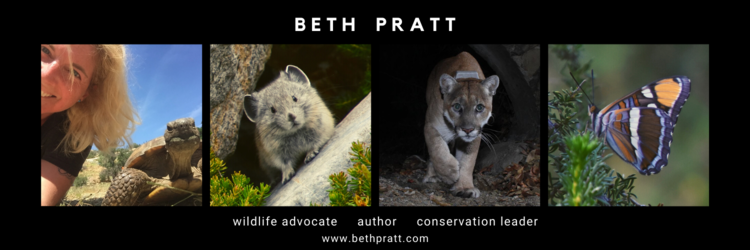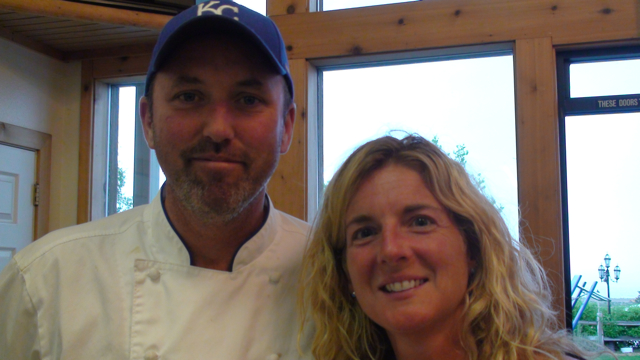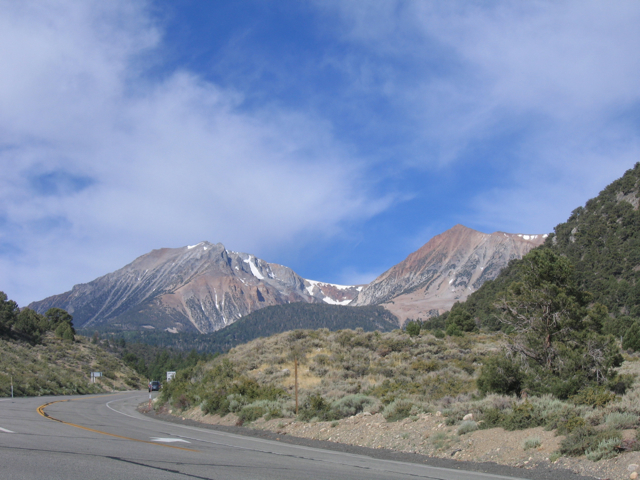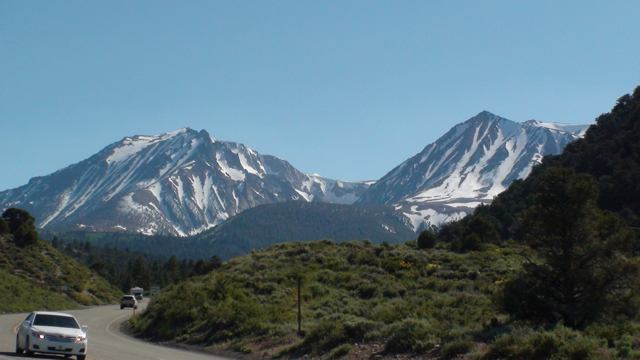 Gaylor Lakes and Gaylor Peak (photo by Beth Pratt)Yesterday I ventured up to Tuolumne Meadows and Tioga Pass to do some wandering. My orginial intent was to climb Mammoth Peak, but the almost full snow coverage on its shoulder forced me to reconsider. Instead I had a nice hike to Upper Gaylor Lake and the Great Sierra Mine area on the border of Yosemite. As I traversed snow fields and walked by creeks reinvigorated with the newly melting snow, it was almost reminiscent of a spring landscape. Yet the vegetation attested to it being fall, painting the hillsides in browns, reds and yellows.
Gaylor Lakes and Gaylor Peak (photo by Beth Pratt)Yesterday I ventured up to Tuolumne Meadows and Tioga Pass to do some wandering. My orginial intent was to climb Mammoth Peak, but the almost full snow coverage on its shoulder forced me to reconsider. Instead I had a nice hike to Upper Gaylor Lake and the Great Sierra Mine area on the border of Yosemite. As I traversed snow fields and walked by creeks reinvigorated with the newly melting snow, it was almost reminiscent of a spring landscape. Yet the vegetation attested to it being fall, painting the hillsides in browns, reds and yellows.
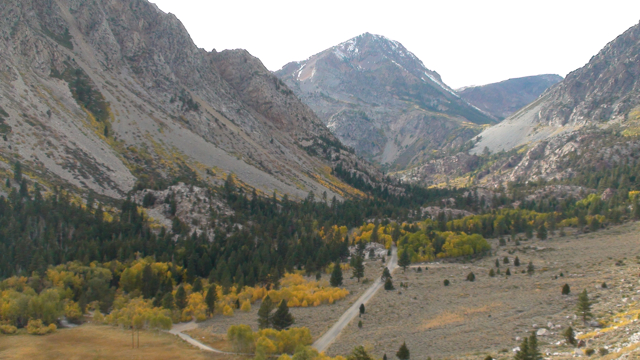 Fall color in Lee Vining Canyon (photo by Beth Pratt)
Fall color in Lee Vining Canyon (photo by Beth Pratt)
After my hike, I drove down Lee Vining Canyon to gaze at the aspen trees (and of course make my usual stops at the Whoa Nellie Deli and Latte Da Coffee Cafe (oh, the pumpkin spice coffee cake!). The canyon is about midway through its fall color transformation and I am guessing it will peak this week. I'll be interested to learn how this early dumping of snow (over a foot in some places) impacts the fall color.
I followed the delightful specter of sun dogs on my drive back up the pass. Ice crystals refracting the sunlight create sun dogs and halos. The two hexagonal crystal types most likely to create these optical phenomena are shaped like six-sided wafers and columnar pencils. Both have eight surfaces capable of refracting light. As depicted in the photo with this entry, sundogs and halos can accompany each other.
 Sun dog over Mt GibbsSundogs appear in a diverse cross-section of history and literature, as a entry in Wikipedia demonstrates. Artistole's work mentions "two mock suns," and Cicero's On the Republicexamines the parhelion. In The War of the Roses, the appearance of sundogs was viewed as an omen of victory for the Yorkists.
Sun dog over Mt GibbsSundogs appear in a diverse cross-section of history and literature, as a entry in Wikipedia demonstrates. Artistole's work mentions "two mock suns," and Cicero's On the Republicexamines the parhelion. In The War of the Roses, the appearance of sundogs was viewed as an omen of victory for the Yorkists.
In modern times, sundogs appear in Nabakov's novel, Pale Fire, provides the title for a Stephen King novella and Jack London short story, and even warrant a mention in the rock group Rush's song "Chain Lightning" (band member Neil Peart is a weather fanatic).
Being a dog-lover, I wanted to know the origin of the name and oddly enough most of my weather books remained mute on the topic. But I dug up the answer in my Weatherwise magazine archives (yes, I am that much of a weather geek). In the November 2002 issue, author Stephen Wilk answers the question 'whose dogs are the sun dogs?' in the article "Every Dog Has Its Day." He provides a few explanations, one of them being that the Germanic sky god Odin possessed two hounds/wolves, Geri (Ravener) and Freki (Glutton). For more information on sun dogs, you can read an excellent description on The Weather Doctor's site.
More photos from my wanderings:
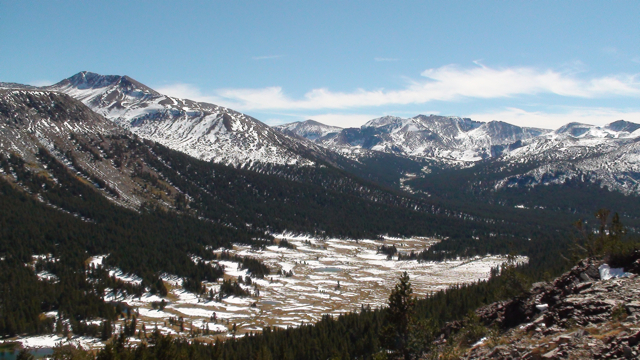 Dana Meadows, Mt Gibbs and the Kuna Crest from Gaylor Ridge (photo by Beth Pratt)
Dana Meadows, Mt Gibbs and the Kuna Crest from Gaylor Ridge (photo by Beth Pratt)
 Aspen trees in Lee Vining Canyon (photo by Beth Pratt)
Aspen trees in Lee Vining Canyon (photo by Beth Pratt)
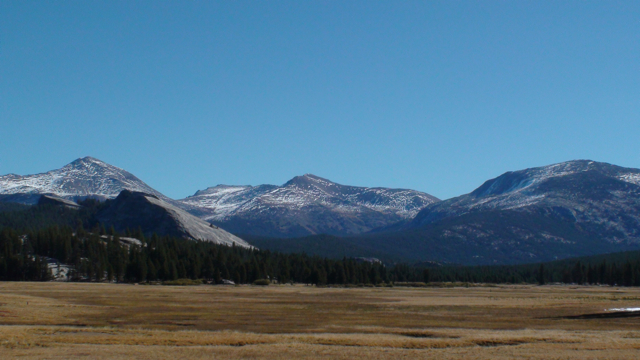 Mt Dana, Gibbs and Mammoth Peak from Tuolumne Meadows (photo by Beth Pratt)
Mt Dana, Gibbs and Mammoth Peak from Tuolumne Meadows (photo by Beth Pratt)
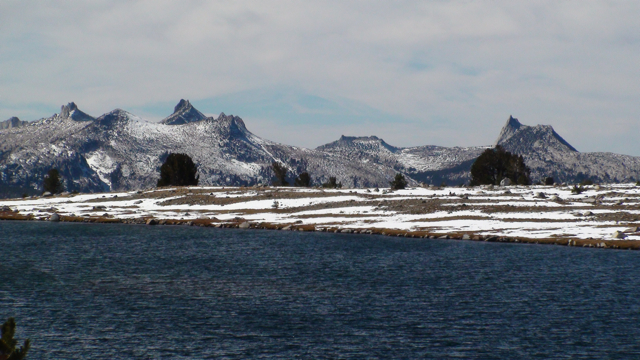 Unicorn and Cathedral Peaks from Gaylor Lake (photo by Beth Pratt)
Unicorn and Cathedral Peaks from Gaylor Lake (photo by Beth Pratt)
 Sun dog over Mt Gibbs (photo by Beth Pratt)
Sun dog over Mt Gibbs (photo by Beth Pratt)
